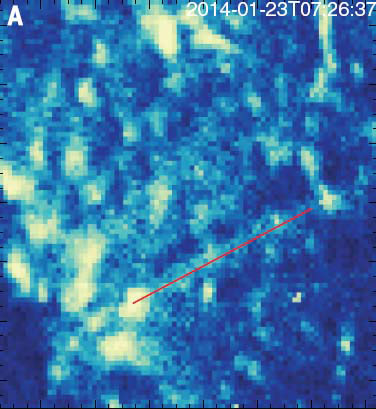
An ultraviolet image of a solar network jet taken by the IRIS mission. The region of the Sun shown is about 10,000 kilometers on a side, and the jet, originating from a bright spot, is highlighted by the red line. Credit: NASA/IRIS
In a newly published study, astronomers from the Harvard-Smithsonian Center for Astrophysics reveal the detection of intermittent, small-scale jets from the solar chromosphere and their possible contribution to the stellar wind.
The solar chromosphere is the region between the Sun’s surface and its hot, million-degree corona. Within this complex interface zone, only a few thousand kilometers deep, the density of the gas drops by a factor of about one million and the temperature increases from about five thousand to one million kelvin. Almost all of the mechanical energy that drives solar activity is converted into heat and radiation within this interface. Many physical processes shape the intricate system of solar magnetic fields, energetic particles, and radiation that power the corona. The solar wind itself has long been suspected of originating in this region, perhaps in the cooler “coronal holes, but identifying the precise origin sites required high spatial resolution observations.
In the summer of 2013, NASA launched the Interface Region Imaging Spectrograph (IRIS) mission to study this interface region in ultraviolet light; the CfA and its staff contributed its twenty-centimeter telescope as well as to its science team. The latest issue of Science features IRIS results, and in it, CfA astronomers Hui Tian, Ed DeLuca, Steve Cranmer, Leon Golub, Sean McKillop, Katherine Reeves, Patrick McCauley, Paola Testa, Mark Weber, and Nicholas Murphy join with their colleagues in announcing the detection of intermittent, small-scale jets from the region and their possible contribution to the stellar wind. The paper is one of five in this special issue of Science which they led or co-authored.
The astronomers found unambiguous evidence for these jets that are roughly about 8,000 thousand kilometers long and 300 kilometers wide, moving between about 80 to 250 kilometers per second, with gas at temperatures of at least one hundred thousand kelvin, and coming in bursts lasting between about 20 and 80 seconds. The upward flowing hot gas may provide the heated mass to the solar wind. The scientists calculate that although intermittent, the ongoing presence of these jets could provide in principle more than enough material to supply the wind. They caution, however, that much work remains to confirm the conclusions and refine the analyses and models – but in any case the newly discover jet phenomenon will need to be incorporated in any future, detailed wind models.
Reference: “Prevalence of small-scale jets from the networks of the solar transition region and chromosphere” by H. Tian, E. E. Deluca, S. R. Cranmer, B. De Pontieu, H. Peter, J. Martínez-Sykora, L. Golub, S. Mckillop, K. K. Reeves, M. P. Miralles, P. Mccauley, S. Saar, P. Testa, M. Weber, N. Murphy, J. Lemen, A. Title, P. Boerner, N. Hurlburt, T. D. Tarbell, J. P. Wuelser, L. Kleint, C. Kankelborg, S. Jaeggli, M. Carlsson, V. Hansteen and S. W. Mcintosh, 17 October 2014, Science.
DOI: 10.1126/science.1255711

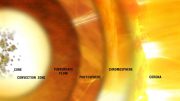
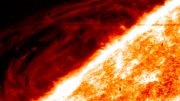
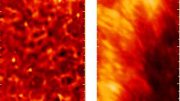
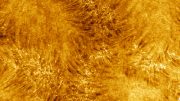

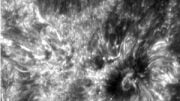


Be the first to comment on "Small-Scale Jets from the Solar Chromosphere Are Possible Sources of the Solar Wind"